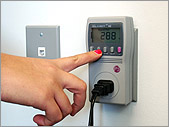
For this first table, I wanted to see how much energy was being consumed by audio/visual components that were plugged into the wall, but not powered on. Indeed some of these numbers are eye-opening:
| Device | Watts consumed (powered
off) |
| Visio 22" LCD HDTV (circa 2007) | 1.58 |
| Visio 32" LCD HDTV (circa 2009) | 1.18 |
| 25" RCA Tube TV (circa 1990) | 4.17 |
| Marantz AV Surround Reveiver SR7200 | 2.79 |
| Marantz CD Changer CC9100 | 1.43 |
| Marantz DVD Player DV6200 | 3.60 |
| Boston Micro90pv II Subwoofer | 14.53 |
| Microsoft Xbox 360 | 3.64 |
| Nintendo Wii | 2.70 |
| Sony PlayStation 2 | 0.67 |
| Scientific Atlanta Explorer 4250HD set top | 17.27 |
| Scientific Atlanta Explorer 8300HD DVR set top | 20.00 |
The granularity of the P4460 is hundredths of kilowatt-hours, which means that in order to get a decent reading on a low-power device, you've got to leave it attached for a while. No doubt some of these measurements could be more accurate, but I think you get the point. Of note:
For the most part, these components are non-critical, and one could argue that some (e.g the stereo) should be connected to a power strip with an on/off button. This should not pose much of an inconvenience. However, it's a completely different story when it comes to the video components. When powered cycled, set top boxes take forever to reach full functionality as they reboot over the cable network. And televisions, if left untethered to electric power for too long, go through this whole channel search sequence when they're powered up. In short, when it comes to video, you're currently stuck with paying the hidden price of "convenience".
For the computer nerd in us, here's a table comprising some of the computer/network-related components that are left on 24x7.
| Device |
Watts Consumed |
|
| Belkin Wireless G Router |
5.09 | |
| Motorola SBV5120 SURFboard Cable Modem |
5.40 | |
| Netgear ProSafe 16 port 10/100 Switch (FS116) |
8.33 | |
|
4.78 | |
| HP Laserjet 4P (circa 1994) |
5.32 | |
| Canon ImageCLASS MF4270 all-in-one laser
printer (networked) (circa 2009) |
3.60 | |
| Fit-PC Slim with external USB hard disk
(network file server) |
7.50 |
A decade ago, devices like those listed above were virtually non-existent in the home. So what's the cost of being Internet ready anytime, anywhere? About 40 watts all day and all night. Some final points: